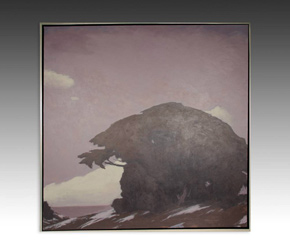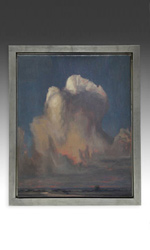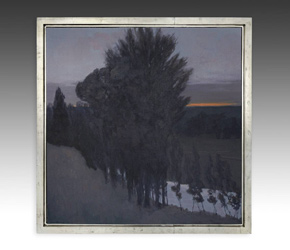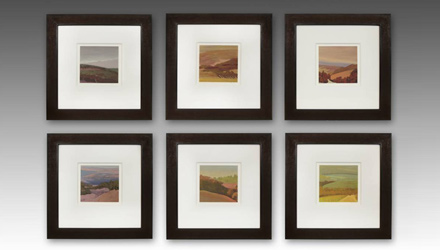Brian Sindler - Nocturnes
PRIMITIVE - Thursday, November 07, 2019By Glen Joffe
 |
|
|
|
布莱恩·辛德勒(Brian Sindler)是一位屡获殊荣的美国艺术家,他的作品体现了景观绘画的本质。它们被称为景观渲染,因为它们不打算确切的渲染。辛德勒在一个沉浸在艺术的家庭中长大。早期,他学习音乐,最终成为巡回音乐家。但是,视觉艺术一直在呼唤。在美国艺术学院和代表艺术学院,辛德勒研究了传统人物绘画。他从这个早期开始的一些作品具有相关的质量。辛德勒可能一直呆在身影绘画和绘画上,除了有一天,一位画家邀请他离开工作室并在阳光下涂漆。Mildly frustrated with his initial attempts at landscape painting, he decided to return to the model named Nature until he ‘got the hang of it.’ In an instant, ten years had passed and never once did he miss the static, literal nature of figure drawing.
 |
|
|
|
简单地将Sindler标记为景观或Plein Air(露天)画家将很容易,但是他的作品涵盖了更大的深度和复杂性,可以降级为单一的样式或创作方法。他开发了一种独特的视觉语言,遍布着景观绘画,概念艺术,现实主义甚至超现实主义的边界。他在每幅画中传达的经验都是基于无数影响的。
While color and light are focal points in Sindler’s artistic process; shapes, composition and design are integral to his working process. From initial sketches to finished pieces, he thinks in terms of shape when it comes to elements like trees, ground, water, sky, clouds, or architectural structures. When he first goes outside, Sindler may make as many as a hundred sketches, ultimately choosing only a handful to translate into paintings. There may be a thousand details in any given landscape, but not all of them are relevant to his work. Many are inevitably omitted as editing is critical to his vision. His sketches represent the schematic simplification of a location; and in the next step of his working process he selects and refines which sketch design to pursue. According to Sindler, finding the right “armature” for a painting is half the battle.
 |
|
|
|
所有颜色是否都可以通过每只眼睛观看?显然不是;正如最近的研究表明,颜色感知实际上是从经验中得出的。由于没有两个人也有相同的经验,甚至没有相同的双胞胎,因此可以说非彩色盲人,视力的人可能会以不同的方式看到相同的颜色。然而,无论我们如何解析阴影,它的确定性颜色和情感都是紧密相关的。帕勃罗·毕加索(Pablo Picasso)曾经说过:“颜色像功能一样,遵循情绪的变化。”这是另一种说法;熟练的艺术家可以操纵色彩以引起情感反应。辛德勒(Sindler)是为此目的使用颜色的主人。对他的艺术过程至关重要; color is a tool he intentionally wields to evoke moods rather than dutifully replicate views.
In fact, Sindler rarely duplicates the exact colors appearing in the scenes he depicts. Rather, he observes the effects of light upon natural color; his final choices reflecting the colors he perceives during different day parts. Those color choices are tempered by a limited palette, which he acknowledges came about from an intense desire to fully understand color when he was in art school. Sindler uses only four variations of the three primary colors – red, blue and yellow – counting two shades of red, one cool and one warm, among the colors he deploys. His dexterity in mixing those basic pigments is a tribute to his refined color sense. However, his adjustment of this palette’s values – the range they run from light to dark – is what fully allows him to create, temper and refine the mood and atmosphere of his paintings. His unique, masterful ability to adjust color value compels the viewer to perceive his work from the standpoint of feeling rather than logic; and ultimately, to fully share his experience of the outdoor world.
.jpg) |
|
|
|
在格式方面,确定他的ca的大小nvas for a given painting is one of the first things Sindler considers. A dichotomy exists in his choices. In many of his large scale paintings, his subjects are depicted up close and more intimate. You might say, the closer the shapes, the larger the canvas. In these works, the viewer is forced to consider their connection to the location, to consider the atmosphere and “feel the breeze” as they become part of the landscape. In his smaller format paintings, the opposite tends to be true. He is inclined to zoom out and portray wide vistas, rolling landscapes and views with more information. In a sense, bigger scenes equal smaller canvases. He discovered this tendency in a series of gouache paintings he did on an inspiring trip to Tuscany, Italy; an area the artist regularly visits.
.jpg) |
|
|
|
辛德勒(Sindler)的最新动力集中在夜间绘画上。如果人们关心探究艺术史,夜曲绘画是由艺术家詹姆斯·麦克尼尔·惠斯勒(James McNeill Whistler)创造的一句话,这位欧洲的美国艺术家(American Artist)活跃于19世纪。惠斯勒(Whistler)是哲学“艺术”哲学的主要支持者,从音乐词中改编了夜曲。它描述了描绘夜晚发生的场景的绘画,暮光,光明的面纱或没有直接光线。正如辛德勒(Sindler)的作品所应用的那样,它描绘了描绘夜景的绘画以及捕捉黑暗外围的绘画。瞬间,光已经消退,我们充满了心情,惊奇和期待的气氛。
不管在辛德勒的夜曲中没有多少光,剩下的一切都是这些绘画中的关键要素。好像他已经完全打开了自己的视野的光圈。然而,它可以保持开放的时间充其量是任意和不精确的,因为这些绘画捕捉了褪色,短暂的时刻。辛德勒(Sindler)对夜曲绘画的礼物是他用刷子停止时间的能力,因此我们可以永久体验和居住在短暂的和短暂的时刻。在他的许多作品中,一天中的时间不确定。例如,考虑一下绘画“阿姆斯特丹夜”和“纽约黎明”,这两幅先前展出的屡获殊荣的作品。如果标题并不私密,那么在日光进入或退出之前,我们仍然会留在居住的那一刻。在画“森林方式”中,我们不喜欢一天中的时间。在这和他的许多夜曲中,无论太阳即将来临还是无关紧要。在所有这些中,我们都有一个永恒的刺穿面纱并考虑到他们揭示的时刻。
辛德勒的夜曲绘画被描述为喜怒无常的。我们所有人都拥有和分享回忆的门户。记忆是否显得清晰,清晰,微弱和脆弱;叙述时,它们不涉及我们的感官。换句话说,记忆存在于物理世界之外。尽管那是他们可能被点燃的地方。连接所有记忆的共同点是它们在我们脑海中的图片中出现。尽管这些图片可能以不同程度的强度出现,但它们就像将我们与其他人,地点,时间和情况联系起来的桥梁。这在画“钢桥”中很明显。它描绘的场景似乎是如此熟悉,大多数观众都问:“我以前看过吗?” Another question arises: “Where?” And still another: “When?” The same questions arise with Sindler’s award-winning house paintings. It does not matter if you passed through a middle class suburb in Somewhere, USA and felt an affinity to brick houses at night. Everyone can relate to an illuminated entrance or window; to the realization that something exists beyond the light, whether it comes from a single bulb hanging in a doorway or a pane of glass encased in a frame.
 |
|
|
辛德勒的风格在景观画家中是独一无二的。与他的技能相称,为他赢得了多个奖项和国际认可。他工作的一个独特方面是它在深层内脏的层次上同时镇静和搅动的能力。邀请我们沉思地检查他的绘画。同时,促使人们思考和探索他们唤起的情绪。简而言之,他的绘画在移动。他们吸引观众;不要以惊人的图像或令人毛骨悚然的色彩将它们与他们踢过头部;但是,相反,通过强调用安静的视觉语言说话。最终,他的画描绘了一个他所看到的世界。 They are not mere documentations of outdoor scenes; but interpretive renderings leaving genuine impressions. Finally, upon examination we are invited to interpret them in the exact spirit they were rendered.